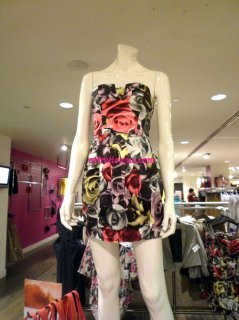Support you so much.
Some people are really innocent enough to deduce all those big designers could do amazing quality under mid-priced budget for mass market. That makes me laugh.
If there's no difference between a Lanvin piece and a Lanvin-H&M piece, how ridiculous and embarrassing could it be to design a collaboration line as a so-called high Fashion designer? Less production, cheaper fabric, that's the basis of a H&M collaboration, or the budget would be really awful. You expect to buy a Lanvin jacket under few hundred dollars? All you can buy is similar look authorized by Lanvin, without being caught as a copy cat.
The truth however
is that Alber Elbaz' designs for Lanvin are technically not so challenging to replicate in terms of craft, unlike, say, some of Olivier Theyskens' designs for Rochas, where even the simplest dress or skirt would in fact have an incorporated corsetry or underpinning to achieve the desired shape.
Alber Elbaz' Lanvin is essentially deconstructed and whereas a sportswear-constructed garments usually have a more relaxed comfort level in wearing, it also simplifies the production a great deal. The same actually accounts for the fabrics; even though Lanvin also makes use of expensive, washed silks, lace and swarovski beading for some of their showpieces, the majority of goods that end up on the salesfloor are made from (mostly Japanese) Cupro or Polyester fibres, which are breathable, hi-tech and quintessentially more adaptable to real life situations, but also not nearly as expensive as the old-school couture fabrics, which often cost around 40€ per meter and up.
Despite these points, it is quite well known that large fashion groups such as Fast Retail group (to which +J, Jil Sander's Uniqlo collection, Theyskens' Theory as well as Helmut Lang belong), PPR (YSL, Stella McCartney, McQueen, Gucci, Balenciaga) etc. are known to have very streamlined fabric purchases in which the management urges the designers to use certain fabrics they buy in huge bulk orders, in which way, they can again save up on costs that can eventually be put on a higher margin... This probably explains how a company such as Stella McCartney can ask for high-end prices while their average fabrics cost are at only 7€ /m (a befriended, former PPR executive confirmed these infos to me).
So quintessentially, I do think that H&M *should* have all the means to save up considerably on the manufacturing of such goods if they wanted to, based on:
- the amounts of production they can provide,
- the distribution they handle all by themselves worldwide,
- the lower margins they can calculate with, as these designer collaborations are more importantly intended to give their company profile a high fashion credibility that their usual goods would not possess.



 I actually agree..not blown away yet.
I actually agree..not blown away yet. she said she will never ever gonna enter in a Lavin store anymore. Well... My heart is devided...
she said she will never ever gonna enter in a Lavin store anymore. Well... My heart is devided...  From one side I'll be really happy buying something that looks exactly from the runway (if I were a woman
From one side I'll be really happy buying something that looks exactly from the runway (if I were a woman  ) but in the other side... I will feel kind of insulted if I were a Lanvin buyer.
) but in the other side... I will feel kind of insulted if I were a Lanvin buyer.










